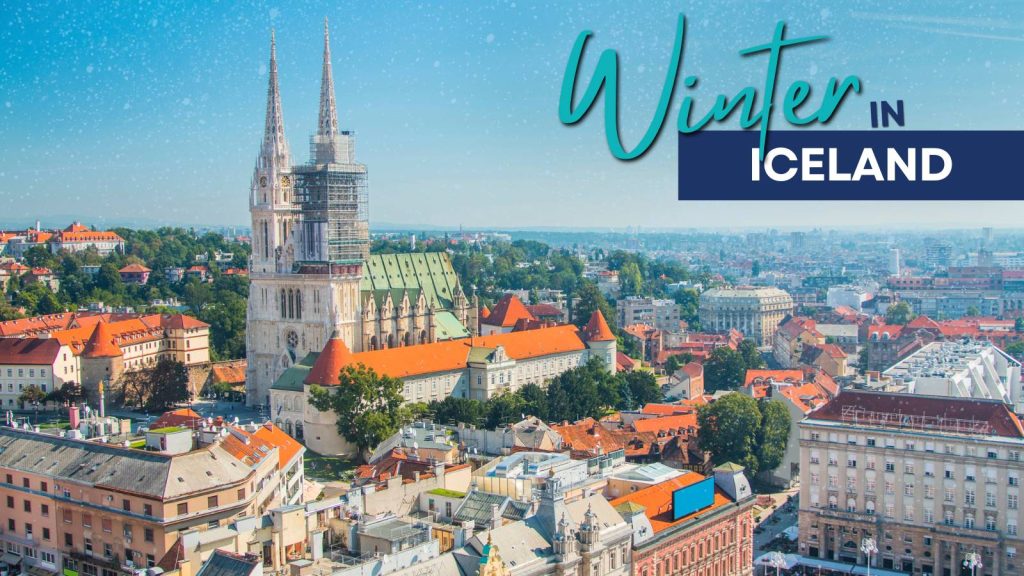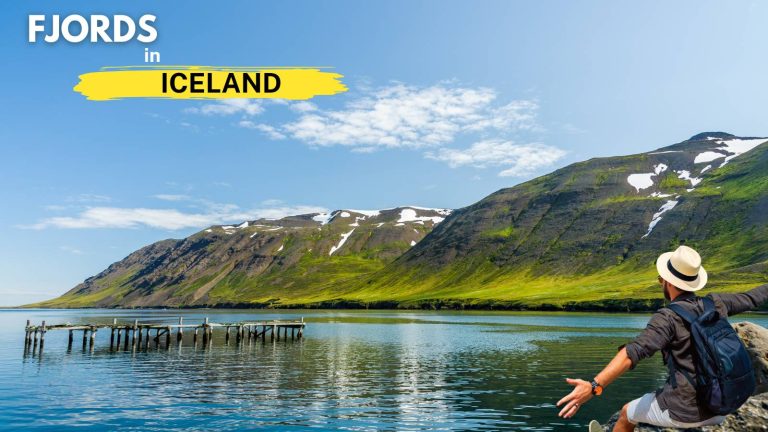Iceland is a dream destination for travelers who love dramatic landscapes, stunning waterfalls, geothermal wonders, and the ethereal glow of the Northern Lights. While many associate Iceland with expensive ski trips and luxury tours, winter in Iceland can also be an incredibly enriching experience for budget travelers.
Top 10 Hidden Fjords in East Iceland That Most Tourists Miss
From exploring snow-dusted volcanoes to relaxing in natural hot springs, this guide will show you how to enjoy Iceland in winter without overspending, even if skiing isn’t on your itinerary.
Planning Winter Trip to Iceland
Best Time to Visit Iceland in Winter
Winter in Iceland runs from late November to early March, offering a unique blend of icy landscapes, frozen waterfalls, and limited daylight hours that create an enchanting atmosphere. While December and January have the shortest days, they also provide the best opportunities to witness the Northern Lights.
February and March, on the other hand, bring slightly longer daylight hours, making sightseeing more manageable while still preserving the magic of a winter wonderland. For budget travelers, visiting during the shoulder months—late November or March—can mean lower accommodation and flight costs.
Budget-Friendly Flights and How to Find Them
Flights to Iceland can be surprisingly affordable if booked in advance. Budget airlines such as WOW Air and Icelandair occasionally offer promotional fares. Using flight comparison websites like Skyscanner, Google Flights, or Momondo allows you to track price fluctuations.
Flexibility is key; sometimes flying mid-week instead of weekends can save hundreds of dollars. Another tip for budget travelers is to fly into Keflavik International Airport and plan public transport or rental cars strategically to avoid unnecessary costs.
Affordable Accommodation Options
Iceland may seem expensive for lodging, but budget-friendly options do exist. Hostels are widespread, offering dorm-style rooms at reasonable prices. Guesthouses and farm stays can provide a cozy and authentic Icelandic experience. Airbnb is also a viable alternative, especially if you plan to self-cater.
Many budget travelers also take advantage of Airbnb homes with kitchen facilities, which significantly reduces food costs. Booking early is crucial during winter months, as options become limited.
Getting Around Iceland on a Budget
Public Transport vs. Renting a Car
While Iceland doesn’t have a vast public transport network outside Reykjavik, buses run to many key destinations. For budget travelers, combining bus routes with affordable day tours can cover most major attractions.
Alternatively, renting a small car can be cost-effective if shared among a group. Choosing a compact car reduces rental and fuel costs, while providing flexibility to stop at off-the-beaten-path locations.
Tips for Driving Safely in Icelandic Winter Conditions
Winter driving in Iceland requires caution due to icy roads, snowstorms, and limited daylight. Ensure your vehicle is equipped with winter tires and carry a GPS or offline maps. Checking road conditions regularly via the Icelandic Road and Coastal Administration website can prevent dangerous situations.
If driving isn’t comfortable, guided day tours or hop-on-hop-off buses are budget-friendly alternatives to reach popular destinations safely.
Carpooling and Budget Tour Options
For travelers without a car, carpooling services and budget tours are practical options. Companies offer day trips to the Golden Circle, South Coast, and Northern Lights hotspots at reasonable rates. Joining small group tours also helps reduce costs while providing insights from local guides.
Must-See Natural Wonders Without Breaking the Bank
Golden Circle Highlights for Budget Travelers
The Golden Circle is Iceland’s most famous route and can be explored on a budget. Highlights include Þingvellir National Park, Geysir geothermal area, and Gullfoss waterfall.
Entry to these sites is free, and guided tours are optional. Renting a car or joining a budget tour allows travelers to cover all three in a day without spending excessively.
Waterfalls You Can Visit for Free
Iceland is a country of waterfalls, and many are accessible without a fee. Seljalandsfoss, Skógafoss, and Dettifoss are among the most popular, providing breathtaking winter scenery.
During winter, frozen icicles create surreal photo opportunities, making these waterfalls ideal for travelers looking to experience Iceland’s natural beauty at no cost.
Black Sand Beaches and Coastal Landscapes
Reynisfjara black sand beach and its basalt columns offer dramatic views of the Atlantic Ocean. Winter brings fewer crowds, allowing for peaceful exploration. Always exercise caution near the waves, as they can be unpredictable.
Coastal drives along Iceland’s South Shore reveal rugged cliffs, puffin nesting sites (in warmer months), and stunning winter vistas—all without any entry fees.
Ice Caves and Glacier Hikes (Low-Cost Options)
While professional ice cave tours can be pricey, some caves and frozen lava tunnels are accessible with local guides at lower costs. Hikes on smaller glaciers or snow-covered trails often require minimal equipment if you rent crampons and trekking poles.
These experiences provide a thrilling winter adventure without breaking your budget.
Affordable Activities for Winter in Iceland
Northern Lights Hunting on a Budget
The Northern Lights, or Aurora Borealis, are one of Iceland’s most iconic attractions. While private tours can be expensive, many budget travelers opt for free aurora hunting. Remote locations like Þingvellir National Park or Vik offer dark skies away from city lights. Websites and apps that track aurora activity make planning easier, ensuring you catch the lights without paying for a guided tour.
Geothermal Pools and Hot Springs
Iceland’s geothermal pools are a winter favorite. While the Blue Lagoon is famous, it can be costly. Budget alternatives include public swimming pools like Laugardalslaug in Reykjavik or natural hot springs such as Seljavallalaug. These options are inexpensive, provide a relaxing soak, and offer an authentic Icelandic experience.
Free Walking Tours in Reykjavik
Reykjavik is compact and walkable, making free walking tours an excellent way to explore the city. Learn about Icelandic history, architecture, and local culture without spending a fortune. Walking tours also allow you to discover street art, cafes, and shops that may not be highlighted in traditional guidebooks.
Exploring Small Towns and Scenic Routes
Driving or taking buses to smaller towns like Vik, Hofn, and Akureyri lets budget travelers experience Iceland’s charm off the beaten path. Winter scenery transforms these towns into magical landscapes of snow-capped rooftops and frozen waterfalls. Exploring these towns on foot or taking low-cost local tours is an enriching and affordable way to travel.
Budget-Friendly Food and Drink Options
Cheap Eats in Reykjavik
Eating out in Iceland can be expensive, but budget travelers can find affordable meals at hot dog stands, fish-and-chip shops, and local cafes. Bæjarins Beztu Pylsur is famous for Icelandic hot dogs, offering a quick and inexpensive meal option.
Grocery Shopping Tips for Travelers
Shopping at local grocery stores like Bonus or Kronan allows you to prepare your meals and save significantly. Stock up on bread, dairy, snacks, and ready-to-eat meals. Many hostels and guesthouses provide kitchen facilities, making self-catering a practical and cost-effective choice.
Self-Catering to Save Money
Preparing your own meals not only reduces food costs but also allows you to enjoy Icelandic ingredients such as lamb, fish, and skyr (Icelandic yogurt) without the restaurant markup. Cooking meals can also be a fun and cultural experience during winter evenings.
Money-Saving Travel Tips for Winter
How to Avoid Peak Tourist Prices
Visiting popular attractions early in the morning or late afternoon can help avoid crowds and sometimes reduce costs. Booking tours and accommodations in advance often results in discounts. Traveling in small groups can also lower per-person costs for car rentals or guided tours.
Packing Smart to Avoid Extra Costs
Winter in Iceland requires layering, waterproof gear, and sturdy boots. Renting equipment or buying locally can be expensive. Packing proper clothing and accessories from home avoids last-minute purchases and ensures you stay comfortable in harsh weather conditions.
Apps and Resources for Budget Travelers
Using apps like Rome2Rio, Google Maps, and Vedur (for weather) can help budget travelers plan routes efficiently. Travel forums, blogs, and local social media groups often share free or low-cost events, hot springs, and seasonal tips that enhance your experience without adding expenses.
Sample 3-5 Day Winter Itinerary on a Budget
Day 1: Reykjavik and Surroundings
Explore Reykjavik on foot, visit Hallgrímskirkja Church, Sun Voyager sculpture, and Laugavegur shopping street. End the day at Laugardalslaug geothermal pool.
Day 2: Golden Circle Highlights
Drive or join a budget tour to Þingvellir National Park, Geysir geothermal area, and Gullfoss waterfall. Stop at small towns along the route for snacks and photos.
Day 3: South Coast Adventure
Visit Seljalandsfoss and Skógafoss waterfalls, Reynisfjara black sand beach, and Dyrhólaey cliffs. Consider a low-cost ice cave tour or glacier hike.
Day 4: Northern Lights and Geothermal Pools
Spend the day exploring nearby towns or scenic drives, then head to a remote location at night to hunt for the Northern Lights.
Day 5: Optional Day Trips
Explore Hofn or Vik further, relax in natural hot springs, or enjoy free cultural activities in Reykjavik.
Winter in Iceland doesn’t have to be about skiing or luxury tours—it’s about adventure, discovery, and embracing the raw, untouched beauty of this Nordic paradise.
FAQs
1. When is the best time to visit Iceland in winter?
The best time is from late November to early March. December and January offer the best chances to see the Northern Lights, while February and March have longer daylight hours, making sightseeing easier. Shoulder months like late November or March can also be more budget-friendly.
2. Is Iceland expensive to visit in winter?
Iceland can be expensive, but traveling in winter allows for cost-saving opportunities. Flights are often cheaper, accommodations less crowded, and many natural attractions like waterfalls, beaches, and national parks are free to visit.
3. Can you see the Northern Lights in Iceland during winter?
Yes, winter is the prime season for spotting the Northern Lights. To maximize your chances, visit away from city lights on clear nights, ideally between 9 PM and 2 AM. Apps and local forecasts can help track aurora activity.
4. Do I need a car to travel in Iceland in winter?
A car is convenient but not mandatory. Public buses cover some routes, and budget tours can take you to major attractions. If driving, ensure your vehicle has winter tires and follow road safety guidelines.
5. What are some budget-friendly activities in Iceland during winter?
Free or low-cost activities include visiting waterfalls (Gullfoss, Seljalandsfoss), exploring black sand beaches, hiking glaciers, soaking in geothermal pools, and Northern Lights hunting. Reykjavik walking tours and small-town explorations are also inexpensive.
6. Is it safe to drive in Iceland in winter?
Winter driving is safe if you take precautions. Roads can be icy and snowy, so a car with winter tires is essential. Always check road conditions online, drive cautiously, and avoid unpaved or remote roads in bad weather.
7. What should I pack for winter in Iceland?
Layered clothing is essential, including thermal base layers, waterproof jackets, warm gloves, hats, and sturdy boots. Sunglasses, crampons for icy hikes, and a good camera for capturing the Northern Lights are also recommended.
8. Are there free hot springs in Iceland?
Yes, several natural hot springs are free or very cheap. Seljavallalaug pool, Reykjadalur hot river, and some coastal geothermal areas allow visitors to enjoy a warm soak without paying for the famous Blue Lagoon.
9. How many daylight hours are there in Iceland during winter?
Daylight varies from about 4-5 hours in December to 7-10 hours in February. Short days mean planning activities carefully and prioritizing key sights during daylight hours. Nighttime is ideal for Northern Lights hunting.
10. Can I visit Iceland in winter without skiing?
Absolutely! Iceland offers a wealth of non-skiing experiences, including waterfalls, glaciers, ice caves, volcanic landscapes, geothermal pools, and cultural explorations in Reykjavik. Winter in Iceland is perfect for adventurers seeking unique scenery without hitting the slopes.

